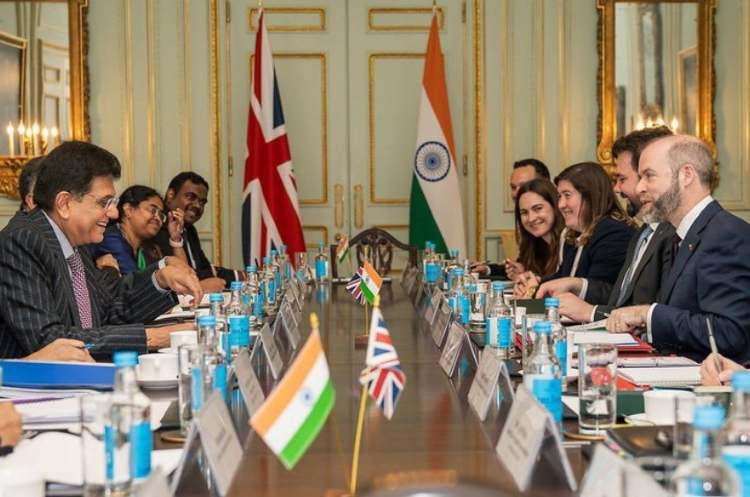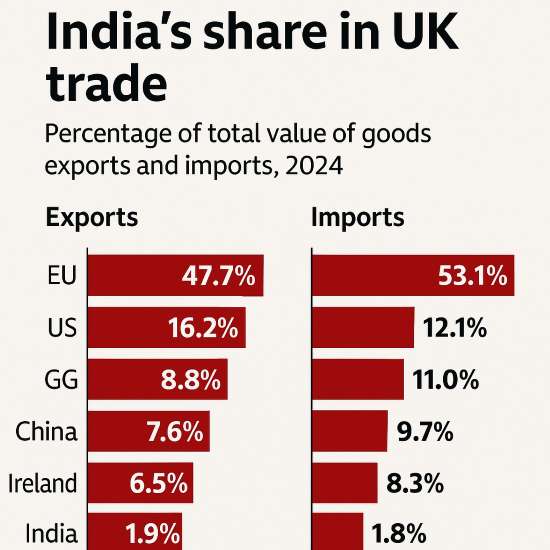
India-UK FTA signed: In a world shadowed by retaliatory tariffs, protectionist rhetoric, and the slow demise of multilateralism, the India-UK free trade agreement is a timely and confident leap in the opposite direction. It affirms that economic pragmatism and liberalism still have their champions. As nations retreat behind tariff walls and weaponise trade policy for domestic posturing, India and the United Kingdom have chosen engagement over estrangement.
The India-UK FTA is pragmatic, balanced, and forward-looking. It is not a perfect deal—no trade agreement ever is—but it advances the strategic, economic, and social interests of both nations. More importantly, it signals to the world that in spite of mounting scepticism about open markets, mature democracies can negotiate mutually beneficial outcomes.
Bilateral trade between India and the UK stood at Rs 4.52 lakh crore ($54.1 billion) in 2024. The India-UK FTA is projected to raise this by a substantial Rs 2.71 lakh crore ($32.4 billion) annually—a remarkable 60% increase, made possible by reductions in tariffs, smoother market access, and greater mobility for professionals. For a UK economy searching for new trade partners post-Brexit, and for an India poised to become the world’s third-largest economy by 2028, this agreement arrives not a day too soon.
READ I India-EU trade talks edge towards truce
India-UK FTA: Gains for India
For India, the benefits from the the India-UK FTA span critical sectors. Textiles, marine products, leather, gems and jewellery, and engineering goods are all poised for a significant export boost. According to the Indian Texpreneurs Federation, textile exports to the UK alone could double, adding Rs 8,400 crore ($1 billion) to India’s export basket. Engineering exports, which already hover around Rs 33,600 crore ($4 billion) annually, are expected to rise as tariffs fall and access improves.

More striking, perhaps, is the victory secured for India’s services sector. The long-sought Double Contributions Convention ensures that Indian professionals working in the UK will no longer be subjected to dual social security contributions. This is more than a bureaucratic relief—it could save Indian firms hundreds of millions of dollars annually, improving competitiveness in sectors like IT, finance, and consulting.
Equally vital is the easing of professional mobility. Visa liberalisation for contractual service suppliers, intra-corporate transferees, and business visitors means skilled Indian professionals can move, work, and contribute more easily to the UK economy. For a country where 65% of the population is under 35, this is not just an economic lever—it is a developmental imperative.
UK’s strategic play post-Brexit
The UK, too, is not merely looking at trade numbers—it is betting on a strategic realignment. India, with its projected import growth of 144% by 2035 and an emerging middle class set to hit 25 crore (250 million), offers a dynamic consumer market that few can afford to ignore.
British exporters of Scotch whisky, premium cars, and optical goods will benefit as steep Indian tariffs begin to recede. For instance, British carmakers—particularly Jaguar Land Rover (JLR), which is owned by Tata Motors—will now enjoy preferential access for their UK-manufactured electric vehicles. With India aggressively pushing its own green transition, JLR’s EV range will find a welcoming and growing market.

Moreover, the UK has secured access to India’s public procurement market worth Rs 4 lakh crore ($48 billion), a first for any nation. British firms, especially SMEs, will now be able to bid for contracts in sectors such as clean energy, infrastructure, and healthcare—domains where the UK possesses both expertise and a comparative advantage.
According to the British government’s own calculations, the FTA could raise UK GDP by $6 billion annually and increase wages by $2.75 billion. These are not esoteric numbers. They translate into more jobs, better incomes, and a wider basket of affordable goods and services for consumers.
Foundation for future-ready trade
As with any deal, there are detractors. Indian whisky makers fear a deluge of cheap imports. Medical device firms worry about a backdoor entry for Chinese products routed through the UK. But these concerns are anticipated and addressed. Robust safeguards—rules of origin, minimum import prices, and anti-dumping provisions—are baked into the agreement.
Across the Channel, UK labour unions have sounded warnings about job losses. These fears are not new, nor are they entirely baseless. But the reality is blunt: the UK cannot bring back industries it no longer competitively produces. Instead, it must lean into sectors where it leads—advanced manufacturing, creative services, finance, and education.
Importantly, the India-UK FTA is not etched in stone. Review mechanisms, dispute resolution frameworks, and renegotiation triggers are embedded within the agreement. The chapters on digital trade, environmental cooperation, intellectual property, and gender equity are not cosmetic—they represent a progressive framework for 21st-century trade.
For India, the FTA complements its Make in India drive and manufacturing ambitions. For the UK, it demonstrates a post-Brexit capability to engage on equal footing with major global economies. Collectively, it is a reaffirmation that trade can still be a tool for shared prosperity, not a battleground of competing nationalisms.
The India-UK FTA is not merely about commodities and customs duties. It is about trust, talent, and technology. It is about opening new doors for workers, professionals, and entrepreneurs. In a global economy marked by suspicion and friction, this FTA is an act of confidence—a rare moment where diplomacy has delivered. It deserves to be applauded, studied, and, most of all, emulated.
